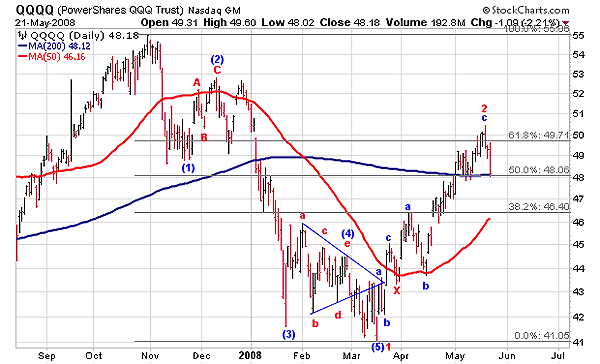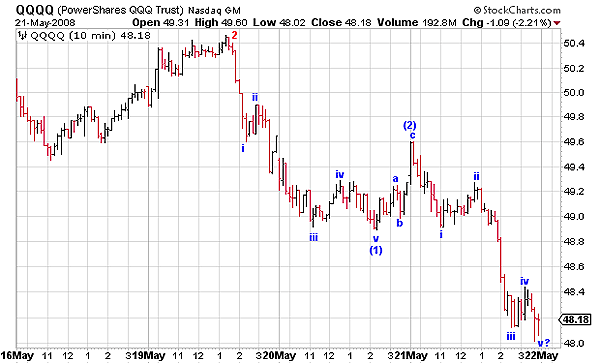
HOT TOPICS LIST
- MACD
- Fibonacci
- RSI
- Gann
- ADXR
- Stochastics
- Volume
- Triangles
- Futures
- Cycles
- Volatility
- ZIGZAG
- MESA
- Retracement
- Aroon
INDICATORS LIST
LIST OF TOPICS
PRINT THIS ARTICLE
by Alan R. Northam
The bear market rally that started in mid-March now looks complete. If the Elliott wave count is correct, then the bear market that started at the end of October 2007 for QQQQ has now resumed.
Position: N/A
Alan R. Northam
Alan Northam lives in the Dallas, Texas area and as an electronic engineer gave him an analytical mind from which he has developed a thorough knowledge of stock market technical analysis. His abilities to analyze the future direction of the stock market has allowed him to successfully trade of his own portfolio over the last 30 years. Mr. Northam is now retired and trading the stock market full time. You can reach him at inquiry@tradersclassroom.com or by visiting his website at http://www.tradersclassroom.com. You can also follow him on Twitter @TradersClassrm.
PRINT THIS ARTICLE
ELLIOTT WAVE
QQQQ Rally Complete?
05/22/08 09:09:13 AMby Alan R. Northam
The bear market rally that started in mid-March now looks complete. If the Elliott wave count is correct, then the bear market that started at the end of October 2007 for QQQQ has now resumed.
Position: N/A
| QQQQ made a bull market high at the end of October 2007 and then sold off from that date till mid-March 2008. During that selloff, QQQQ formed five distinctive waves that meet the Elliott wave rules for an impulsive wave. According to R.N. Elliott, impulse waves define the major trend of the market. In the case of QQQQ, this impulsive wave is in the downward direction, making the major market trend to be a downward trend. Major market trends are defined as either a bull market or a bear market, depending upon its direction. This then puts QQQQ in a bear market, since its major trend direction is in the downward direction. |
| Elliott also states in his market research that once a five-wave impulse wave is complete, the market will enter into a market correction. Elliott defines a market correction to be as simple as a three-wave pattern to a very complex pattern of corrective waves. Figure 1 shows that QQQQ has been moving higher in a bear market corrective pattern since mid-March. The wave count shows that this corrective pattern has traced out a double zigzag wave form. A single zigzag corrective wave is a three-wave affair made up of waves a, b, and c. Elliott uses letters to denote corrective wave patterns and numbers to denote impulsive wave patterns. A double zigzag is made up of two single zigzags connected together by an X wave. Looking at the complete corrective rally off the mid-March lows, it now appears that this rally has completed the double zigzag bear market corrective rally. This latest high price for the corrective rally also comes at a price level just above the Fibonacci retracement level of 61.8%, a high-probability area for retracement rallies to end. |

|
| FIGURE 1: QQQQ, DAILY. This price chart for QQQQ shows an Elliott wave count, 50-day and 200-day moving averages, and Fibonacci retracement levels. This figure also shows QQQQ having closed right at its 200-day moving average. |
| Graphic provided by: StockCharts.com. |
| |
| R.N. Elliott in his studies of the market also states that waves are fractal in nature. What this means is that the five waves that were formed from the late October 2007 top to the low made in mid-March this year, waves (1), (2), (3), (4), and (5) make up wave 1 down (see red 1 at mid-March low). And the double zigzag pattern formed off the mid-March low makes up wave 2 of a much larger impulse wave. This much larger impulsive wave is therefore made up of five waves, waves 1, 2, 3, 4, and 5, or in which waves 1 and 2 appear to be complete. What this further means is that the much larger impulsive wave, which will make up the complete bear market for QQQQ, still has wave 3 down, wave 4 a corrective wave, and wave 5 down to go before this much larger impulsive wave is complete. Therefore, if wave 2, a bear market corrective wave, is now complete, that means that wave 3 down is under way. Due to the fractal nature of waves, wave 3 down will be made up of smaller impulsive waves. So let's look at the 10-minute chart of QQQQ over the last four trading sessions to see if we can see a smaller impulse wave in the downward direction made up of a series of five waves. |
| In Figure 2 I have shown that QQQQ has indeed formed a pattern of five waves in the downward direction labeled waves i, ii, iii, iv, and v. Further, these five waves have formed wave (1) down. I have also shown that a wave (2) corrective wave is made up of a single zigzag wave labeled a, b, and c. I have also shown that wave (3) down is still unfolding and is made up of waves i, ii, iii, iv, and v, of which wave v may not yet be complete. |

|
| FIGURE 2: QQQQ, 10-MINUTE. This 10-minute price chart of QQQQ shows the Elliott wave subwave count. This figure shows an impulsive wave composed of subwaves i, ii, iii, iv, and v. This impulse wave defines QQQQ as being in a bear market. |
| Graphic provided by: StockCharts.com. |
| |
| In conclusion, it looks like the bear market corrective rally from the mid-March lows is now complete, having what looks like a completed double zigzag corrective pattern. Further it looks like wave 3 down is just getting started, as it has completed a small impulsive wave labeled waves i, ii, iii, iv, and v in the downward direction that defines the major direction of the market. The one fly that remains in this ointment is the fact that QQQQ is still trading above its 200-day moving average. When a market is trading above its 200-day moving average, the 200-day moving average provides support for the market. When a market is trading below its 200-day moving average. this average acts as resistance against the market. In bull markets, lines off support are not easily broken by the market trading below them, but lines of resistance is easily broken by the market trading through them. Just the opposite is true in bear markets. In bear markets, lines of resistance is not easily broken through, but lines of support are. Therefore, with QQQQ sitting just above its 200-day moving average, we are about to test if the current market environment is a bull market or a bear market (see my article "Support and resistance lines define market trends" published on 5/15/08 for more on this subject). If QQQQ respects the 200-day moving average, finding it a strong line of support and continues to trade higher, then the Elliott wave count is wrong and the advance off the mid-March lows is the resumption of the bull market trend that started in 2002. However, if QQQQ breaks below its 200-day moving average and continues to trade lower, then the Elliott wave count is correct and this market is in wave 3 down of a bear market. |
Alan Northam lives in the Dallas, Texas area and as an electronic engineer gave him an analytical mind from which he has developed a thorough knowledge of stock market technical analysis. His abilities to analyze the future direction of the stock market has allowed him to successfully trade of his own portfolio over the last 30 years. Mr. Northam is now retired and trading the stock market full time. You can reach him at inquiry@tradersclassroom.com or by visiting his website at http://www.tradersclassroom.com. You can also follow him on Twitter @TradersClassrm.
| Garland, Tx | |
| Website: | www.tradersclassroom.com |
| E-mail address: | inquiry@tradersclassroom.com |
Click here for more information about our publications!
Comments
Date: 05/22/08Rank: 5Comment:

|

Request Information From Our Sponsors
- StockCharts.com, Inc.
- Candle Patterns
- Candlestick Charting Explained
- Intermarket Technical Analysis
- John Murphy on Chart Analysis
- John Murphy's Chart Pattern Recognition
- John Murphy's Market Message
- MurphyExplainsMarketAnalysis-Intermarket Analysis
- MurphyExplainsMarketAnalysis-Visual Analysis
- StockCharts.com
- Technical Analysis of the Financial Markets
- The Visual Investor
- VectorVest, Inc.
- Executive Premier Workshop
- One-Day Options Course
- OptionsPro
- Retirement Income Workshop
- Sure-Fire Trading Systems (VectorVest, Inc.)
- Trading as a Business Workshop
- VectorVest 7 EOD
- VectorVest 7 RealTime/IntraDay
- VectorVest AutoTester
- VectorVest Educational Services
- VectorVest OnLine
- VectorVest Options Analyzer
- VectorVest ProGraphics v6.0
- VectorVest ProTrader 7
- VectorVest RealTime Derby Tool
- VectorVest Simulator
- VectorVest Variator
- VectorVest Watchdog
